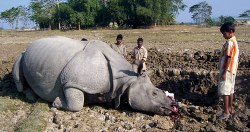THE PROBLEM OF ENVIRONMENTAL CRIME

A 2004 American science-fiction film “The Day After Tomorrow” directed, and produced by Roland Emmerich highlights what the world would look like if the greenhouse effect and global warming continued under the onslaught of environmental crimes being perpetrated by humankind .The film’s protagonist, a climatologist named Professor Jack Hall, discovers that due to global warming, the polar ice caps are melting, lowering ocean temperatures and triggering a massive climate shift causing many natural disasters and eventually a new ice age.
 Our environment has been the victim of all sorts of attacks. As a result, people are experiencing both the subtle and stark effects of climate change. Most of the attacks are human-made such as wars, explosions, chemical spills, etc.
Our environment has been the victim of all sorts of attacks. As a result, people are experiencing both the subtle and stark effects of climate change. Most of the attacks are human-made such as wars, explosions, chemical spills, etc.
If there could be one person who could qualify as the world’s worst environmental criminal, it would probably be Saddam Hussein.
During the 1991 Persian Gulf War, Hussein knew he would lose Kuwait, so he sent men to blow up Kuwaiti oil wells. Approximately 600 were set ablaze, and the fires — towering infernos — burned for seven months plunging the Gulf in poisonous smoke, soot and ash. On April 26, 1986, one of the reactors at the Chernobyl power plant in Ukraine exploded. This was yet another human-made environmental disaster resulting in a nuclear meltdown that sent massive amounts of radiation into the atmosphere, reportedly more than the fallout from Hiroshima and Nagasaki. Around midnight on Dec. 2, 1984, another human-made accident at a Union Carbide pesticide plant in Bhopal, India, resulted in 45 tons of poisonous methyl isocyanate escaping from the facility. Thousands died within hours.
As a result, Interpol decided to fight environmental crime in 1992. Crimes committed in violation of environmental laws are called ecological crimes. Interpol, United Nations Environment Programme and the United Nations Interregional Crime and Justice Research Institute have declared that any contravention to the Convention on International Trade in Endangered Species of Fauna and Flora (CITES) by way of illegal trade in endangered species, dumping and illicit business in hazardous waste in contravention of the 1989 Basel Convention on the Control of Transboundary Movement of Hazardous Wastes and Other Wastes and their Disposal, and Smuggling of ozone-depleting substances (ODS) in contravention to the 1987 Montreal Protocol on Substances that Deplete the Ozone Layer would constitute environmental crimes. It also recognises, illegal logging and the associated trade in stolen timber in violation of national laws, as well as unreported and unregulated fishing as environmental crimes. These crimes are liable for prosecution. Interpol renders possible international police cooperation and supports its member states in the effective enforcement of national and international environmental laws and treaties.
In India, offences against the environment are registered under five laws namely Water (Prevention & Control of Pollution) Act, 1974, Air (Prevention & Control of Pollution) Act, 1981, Environmental (Protection) Act, 1986, Wildlife Protection Act, 1972 and Forest Act, 1927.
As far as India is concerned, Uttar Pradesh topped the list of environment-related offences at (2,130 cases) in 2016, followed by Rajasthan (1,381 cases). Environment-related crimes across India have been on the steady decline – 5,835 cases in 2014, 5,156 in 2015 and 4,732 in 2016. Last year, the WHO list of 30 most polluted cities in the world, included Gwalior, Allahabad and Delhi.
In December 2016, the UN Environment and INTERPOL published a joint Strategic Report on Environment, Peace and Security titled ‘A Convergence of Threats’. In the report, abuse of the environment was highlighted as the fourth most substantial criminal activity in the world. Exploitation of the situation was valued at USD 258 billion, and it was projected to increase by five to seven per cent every year. The environmental crime was, therefore, a growing threat to peace, security and stability besides being a national priority for 80 percent of countries surveyed in the report.
Environmental offences today, are the largest source of funding for non-state militias and terrorist organisations, contributing 38 per cent of their revenue, according to a new study released by Interpol and research workers. For instance, in the Central African Republic, illegal logging of trees earns more money than narcotic trafficking, kidnappings, pillaging, extortion, human trafficking etc. “Transnational organised-criminal groups targeting primarily natural resources and environmental crimes, in or near conflicts, get by far the largest slice of their revenue in conflict zones, often associated with corruption, and powerful political and military elites.” The study mentioned above estimates that total cash flow from illegal timber, illegal fishing, wildlife trafficking and illegal mining to be between US$110 and US$281 billion annually. Of which, between US$22.8 and US$34 billion finds its way to extremists and organised criminal gangs such as al-Shabaab, DRC rebels and the Taliban. Elephant ivory is reported to make between US$4 million and US$12.2 million for sub-Saharan militias each year and illegal logging, which sees revenues of up to US$152 billion annually worldwide, earns US$48 million for armed groups in the DRC.
 The illegal wildlife trade a severe environmental crime is a significant contributor to species endangerment, often the second biggest threat to biodiversity after habitat loss. Illegal wildlife trade is widespread and constitutes one of the significant unlawful economic activities, comparable to the traffic of drugs and weapons. Wildlife trade is a serious conservation problem, hurts the viability of many wildlife populations and is one of the major threats to the survival of vertebrate species. Interpol has estimated the extent of the illegal wildlife trade between $10 billion and $20 billion per year. CITES (the Convention on International Trade in Endangered Species of Wild Fauna and Flora, also known as the Washington Convention) is a multilateral treaty to protect endangered plants and animals. It was drafted as a result of a resolution adopted in 1963 at a meeting of members of the International Union for Conservation of Nature (IUCN).CITES accords varying degrees of protection to more than 35,000 species of animals and plants. Members of terrorist organisations and criminal organisations illegally traffic in hundreds of millions of plants and animals to fund the purchase of weapons, finance civil conflicts, and launder money from illicit sources. The appeal, in part, is the low risk of detection and punishment compared to drug trafficking and a promise of significant profits. For example, a single Ploughshare tortoise from Madagascar (there are only 400 estimated left in the wild) can fetch the US $24,000. Elephant ivory is a commonly trafficked contraband which fetches high prices in destination countries. Ivory prices and demand have skyrocketed. The cost for raw ivory in China was $2,100 per kilogram.”Between 2010 and 2012, up to 33,000 elephants were poached and killed on average each year.
The illegal wildlife trade a severe environmental crime is a significant contributor to species endangerment, often the second biggest threat to biodiversity after habitat loss. Illegal wildlife trade is widespread and constitutes one of the significant unlawful economic activities, comparable to the traffic of drugs and weapons. Wildlife trade is a serious conservation problem, hurts the viability of many wildlife populations and is one of the major threats to the survival of vertebrate species. Interpol has estimated the extent of the illegal wildlife trade between $10 billion and $20 billion per year. CITES (the Convention on International Trade in Endangered Species of Wild Fauna and Flora, also known as the Washington Convention) is a multilateral treaty to protect endangered plants and animals. It was drafted as a result of a resolution adopted in 1963 at a meeting of members of the International Union for Conservation of Nature (IUCN).CITES accords varying degrees of protection to more than 35,000 species of animals and plants. Members of terrorist organisations and criminal organisations illegally traffic in hundreds of millions of plants and animals to fund the purchase of weapons, finance civil conflicts, and launder money from illicit sources. The appeal, in part, is the low risk of detection and punishment compared to drug trafficking and a promise of significant profits. For example, a single Ploughshare tortoise from Madagascar (there are only 400 estimated left in the wild) can fetch the US $24,000. Elephant ivory is a commonly trafficked contraband which fetches high prices in destination countries. Ivory prices and demand have skyrocketed. The cost for raw ivory in China was $2,100 per kilogram.”Between 2010 and 2012, up to 33,000 elephants were poached and killed on average each year.
Illegal logging to get wood for furniture or construction purposes –is another serious environmental crime. It is estimated that illegal logging on public land alone causes losses in assets and revenue more than 10 billion USD annually. Although exact figures are difficult to calculate, estimates show that more than half of the logging that takes place globally is illegal, especially in open and vulnerable areas such as the Amazon Basin, Central Africa, Southeast Asia, the Russian Federation. The Amazon destruction –the largest rainforest in the world –speeded up in 2013 at a 29% rise in deforestation, according to the Brazilian government. Illegal logging not only contributes to deforestation but also to global warming, loss of biodiversity, besides undermining the rule of law. Furthermore, the illicit trade of forest resources threatens international security and is frequently associated with corruption, money laundering, organised crime, human rights abuses and, in some cases, violent conflict.
Illegal fishing, a major environmental crime contributes to over-extraction of fish stocks, disruption of marine food chains and threats to marine biodiversity. Illegal fishing together with shark finning has brought about cataclysmic harm to the marine ecosystem. Shark finning is the practice of extracting the fins from sharks and casting away the remaining shark. The sharks are often still alive when discarded, but without their fins. Unable to swim effectively, they descend to the bottom of the ocean and die of suffocation. Shark fin is the most profitable part of the shark; fishing vessels find that finning helps them increase their lucrativeness by enabling them to transport more fins as the shark meat is bulky to carry. Roughly 73 million sharks die each year by finning, though some reckon that finning kills 100 million sharks each year. Many shark species have become endangered due to shark finning, including the threatened scalloped hammerhead shark. Shark fins are among the most expensive seafood products, commonly retailing at US$400 per kg. In China and its territories, there is a huge demand for shark fin soup and traditional cures.
Ozone depletion and the ozone hole have generated worldwide concern over increased cancer risks and other adverse effects. The leading cause of ozone depletion is manufactured chemicals, especially halocarbon refrigerants, solvents, propellants and chlorofluorocarbons (CFCs), HCFCs, etc. referred to as ozone-depleting substances (ODS). These compounds are transported into the stratosphere by the winds where they release halogen atoms through photodissociation, which catalyse the breakdown of ozone into oxygen. The ozone hole causes most harmful UVB wavelengths of ultraviolet light to pass through which could cause skin cancer, sunburn and cataracts to human populations on earth. The adoption of the Montreal Protocol in 1987, which bans the production of CFCs, halons and other ozone-depleting chemicals is the most successful international environmental agreement to date as ozone hole is expected to reach pre-1980 levels by around 2075.
Dumping in rivers and aquifers is another severe environmental crime most often caused by irresponsible industries. Toxic wastes discharged from factories is being uncontrollably released into the environment, polluting rivers, lakes aquifers, etc. Which is a grave crime as the chemicals percolate into the soil, and cause groundwater pollution. Arsenic and fluoride have been recognised by the World Health Organization (WHO) as the most dangerous inorganic contaminants in drinking water. In the Gangetic Plains of northern India and Bangladesh severe contamination of groundwater by arsenic is seen in 25% of water wells. Nitrates, fluorides, organic compounds and pathogens are often found contaminated in the underground in India.
E-waste or electronic waste is created when an electronic product is discarded after the end of its useful life. In the developed countries up to 50 million tonnes of electronic waste is generated every year (computers, TV sets, mobile phones, appliances, etc.). And up to 75% of it is estimated to be illegally exported to Africa, China or India. The rapid expansion of technology means that an enormous amount of e-waste is created every minute. The USA is reported to discard 30 million computers each year, and about 100 million phones are disposed of in Europe each year. Electronic scrap components, such as CPUs, contain potentially harmful materials such as lead, cadmium, beryllium, or brominated flame retardants.
Governments sometimes are known to be complicit with environmental criminals. The German government either had no role or was complicit in the Volkswagen emissions scandal famously called the “dieselgate”. The United States Environmental Protection Agency (EPA) in September 2015, stumbled upon the scandal and issued a notice of violation of the Clean Air Act to the German automaker. Their investigation disclosed that Volkswagen had intentionally programmed turbocharged direct injection (TDI) diesel engines to activate their emissions controls only during laboratory emissions testing which caused the vehicles’ NOx output to meet US standards during the normative trial, but discharge up to 40 times more NOx in real-world driving. Volkswagen deployed this programming software in about eleven million cars worldwide, including 500,000 in the U.S.A., in model years 2009 through 2015.
Regulators in multiple countries started to investigate Volkswagen, and its stock price tumbled by a third in the days after the news broke out. Volkswagen Group CEO Martin Winterkorn resigned, and the head of brand development Heinz-Jakob Neusser, Audi R&D head Ulrich Hackenberg, and Porsche R&D head Wolfgang Hatz were suspended. Volkswagen announced plans in April 2016 to spend €16.2 billion on rectifying the emissions issues and planned to refit the affected vehicles as part of a recall campaign. In January 2017, Volkswagen pleaded guilty to criminal charges, and in April 2017, a US federal judge ordered Volkswagen “to pay a $2.8 billion criminal fine for rigging diesel-powered vehicles to cheat on government emissions tests”. The scandal raised awareness over the higher levels of pollution emitted by all diesel-powered vehicles from a wide range of carmakers, which under real-world driving conditions exceeded legal emission limits. A study conducted by ICCT and ADAC showed the most significant deviations from Volvo, Renault, Jeep, Hyundai, Citroën and Fiat.
In the 1970s, Love Canal, located near Niagara Falls in upstate New York, was a charming little blue-collar enclave with several hundred houses and a school. It just happened to sit atop 21,000 tons of toxic industrial waste disposed of by Hooker Chemical and Plastics Company in the 1940s and ’50s. After several years of unusually heavy rains, in 1976 the groundwater level started to rise, leaving house foundations overwhelmed with chemical waste. Gardens withered, pets died, and children suffered severe chemical burns on their hands and feet. High rates of congenital disabilities, miscarriage, cancer, and blood disorders, together with other afflictions, were detected. When only 2 of 17 pregnant women in Love Canal gave birth to healthy babies, authorities evacuated the area in grave and imminent peril. Surveys indicated pollution several hundred times above safe levels. The local school was closed, over 200 houses were demolished, and over and above 1,000 families were evacuated. Cleanup and liability costs from the disaster exceeded $200 million.
The new millennium and the modern environmental crisis has created a need for ecologically based religion and spirituality called “Eco-Spirituality” which draws together religion and ecological activism. Another nature-based religion called Paganism has been in existence since long. Many pagans put trust in interconnectedness among all living creatures, which allows them to foster moments of soul-searching before acting. These pagan ideas are coterminous with eco-spirituality because pagans understand the environment to be a part of the holy realm and part of their inner self. Therefore, in their view, harming the environment directly affects their wellbeing.
Source from: epaper/deccanchronicle/chennai/dt:11.02.2019
 Dr.K. Jayanth Murali is an IPS Officer belonging to 1991 batch. He is borne on Tamil Nadu cadre. He lives with his family in Chennai, India. He is currently serving the Government of Tamil Nadu as Additional Director General of Police, DVAC.
Dr.K. Jayanth Murali is an IPS Officer belonging to 1991 batch. He is borne on Tamil Nadu cadre. He lives with his family in Chennai, India. He is currently serving the Government of Tamil Nadu as Additional Director General of Police, DVAC.


